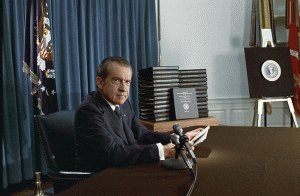Cross-posted from Consortium News

President Richard Nixon, trying to head off impeachment over Watergate, releases edited transcripts of his Oval Office tapes on April 29, 1974.
(Image by (Photo credit: National Archives)) Details DMCA
To fully understand the Watergate scandal, which led to President Richard Nixon's resignation 40 years ago, you have to know the back story starting in 1968 when candidate Nixon took part in a secret maneuver to scuttle the Vietnam peace talks and salvage a narrow victory over Vice President Hubert Humphrey.
In essence, what Nixon and his campaign team did was to contact South Vietnamese leaders behind President Lyndon Johnson's back and promise them a better deal if they stayed away from Johnson's Paris peace talks, which President Nguyen van Thieu agreed to do. So, with Johnson's peace talks stymied and with Nixon suggesting that he had a secret plan to end the war, Nixon edged out Humphrey.
After his election, Nixon learned from FBI Director J. Edgar Hoover that President Johnson had amassed a detailed file on what Johnson called Nixon's "treason," but Nixon couldn't locate the file once he took office and ordered an intensive search for the material that explained why the Paris peace talks had failed. But the material stayed missing.
Nixon's worries grew more acute in mid-June 1971 when the New York Times and other major U.S. newspapers began publishing the Pentagon Papers leaked by former Defense Department official Daniel Ellsberg. Though the Pentagon Papers -- covering the years 1945 through 1967 -- exposed mostly Democratic deceptions, Nixon knew something that few others did, that there was a potential sequel that could be even more explosive than the original.
By mid-1971, an increasingly angry and radical anti-war movement was challenging Nixon's continuation of the conflict. In early May, a series of demonstrations had sought to shut down Washington. Some 12,000 protesters were arrested, many confined at RFK Stadium in a scene suggesting national disorder.
In June, the Pentagon Papers further fueled the anti-war fury by revealing many of the lies that had led the nation into the bloody Vietnam quagmire. So, Nixon recognized the political danger if someone revealed how Nixon's pre-election maneuvers in 1968 had prevented President Johnson from bringing the war to an end. Nixon became desperate to get his hands on the missing report (or file) about the failed peace talks.
In a series of tape-recorded meetings beginning on June 17, 1971, Nixon ordered a break-in (or even a fire-bombing) at the Brookings Institution where some Nixon insiders believed the missing material might be hidden in the safe.
"I want it implemented," Nixon fumed to his senior aides, Henry Kissinger and H.R. "Bob" Haldeman. "Goddamnit, get in and get those files. Blow the safe and get it."
On June 30, 1971, Nixon returned to the topic, berating Haldeman about the lack of action and suggesting that a team be formed under former CIA officer E. Howard Hunt to conduct the Brookings break-in. "You talk to Hunt," Nixon told Haldeman. "I want the break-in. Hell, they do that. You're to break into the place, rifle the files, and bring them in. ... Just go in and take it. Go in around 8:00 or 9:00 o'clock."
There was even talk about fire-bombing the centrist Washington think tank, but the break-in never apparently happened, although Brookings' historians say there was an attempted break-in during that time frame. The historians also say that Brookings never possessed the missing file or report.
Nevertheless, Nixon and his advisers had crossed an important Rubicon, creating a team of burglars who would become known as the Plumbers.
This team, under Hunt's command, would break into the office of Ellsberg's psychiatrist seeking information to discredit the whistleblower and into the Democratic National Committee at the Watergate building on May 28, 1972, to plant bugs and rifle through files. On June 17, 1972, when the team returned to the Watergate to plant more bugs, five of the burglars were arrested by Washington police.
Though Nixon and his team were able to keep a lid on the scandal until the November election, which he won handily over Sen. George McGovern, the cover-up eventually proved to be Nixon's undoing. As investigators closed in on Nixon's use of hush money and other obstructions, some insiders, such as White House counsel John Dean, began to talk.
When Congress learned that Nixon had taped many of his Oval Office conversations, the President faced demands for these recordings, which Nixon fought furiously to protect. Eventually, however, the U.S. Supreme Court ordered the tapes be turned over and Nixon's political fate was sealed. On Aug. 8, 1974, he announced to the nation that he would resign and, on Aug. 9, he signed the official papers and departed from the White House aboard a Marine helicopter.
But the mistaken lesson that the U.S. mainstream media derived from the scandal was that "the cover-up is always worse than the crime," a silly saying that reflected the media's ignorance about what the underlying crime was. In this case, the historical record now shows that Nixon set the Watergate scandal in motion in 1971 out of fear that perhaps his greatest crime would be exposed -- how he sabotaged Vietnam peace talks to gain a political edge in an election.
(Note: You can view every article as one long page if you sign up as an Advocate Member, or higher).





